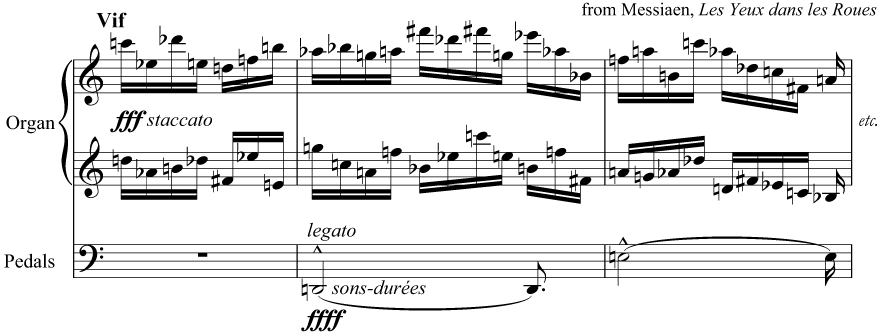Accidentals
In this guide...
Key terms:
Subscription required!
To view the complete study guide, you will need a valid subscription. Why not subscribe now?
Already have a subscription? Make sure you login first!
Introduction
You'll already be familiar with flats and sharps, having seen them in key signatures and in the idea of semitones and tones. In this guide, we'll discover a few more places you'll find them.
Sharps and flats
First of all, let's begin with a brief reminder of sharps and flats.
Sharps and flats are special signs which are used to raise or lower natural notes (C, D, E, F, G, A, B). A sharp sign raises the following note by a semitone, and a flat sign lowers the following note by a semitone.
The sharp sign is: ![]()
And the flat sign is: ![]()
A natural sign has the effect of cancelling out a previous flat or sharp, and ensures that the natural version of the note is played.
The natural sign is: ![]()
Key signatures
Another place you find flats and sharps is in the key signature. Here, the flats and sharps are carried through from the key signature on the left across the stave. In G major for example, which has a key signature of one sharp (F sharp), all of the F's are F sharps.
In the following example, the key signature has one flat (B flat), and so all the B's are B flats.
 Deck the Hall, with a key signature of one flat
Deck the Hall, with a key signature of one flatAccidentals
So far, so good. But what if you want to use one of those different sharp or flat notes, and it isn't available in the key signature? Or what if you want an F natural, but the key signature specifies F sharps throughout?
In these cases, we simply write in the extra flat, sharp, or natural sign, and that takes priority over the key signature. This kind of flat/sharp/natural sign is called an accidental.
The example below shows the familiar tune of Greensleeves, which uses an accidental at several points in the melody.
 Greensleeves, which uses accidentals in the melody
Greensleeves, which uses accidentals in the melodyCancellation
So far, we have learned how to use an accidental to change the effect of a key signature. When an accidental is used, it applies to all following notes of the same pitch. But how do we undo the effect of the accidental?
This "undoing" is called cancellation and can happen in two ways.
1. Barlines
The barline following the accidental will automatically cancel its effect, and when the player reaches the next bar, they will know to ignore the accidental in the previous bar.
2. Another accidental
To cancel an accidental even sooner, it's possible to use another accidental, which in turn will take priority. For example, if we had a key signature of G major (one sharp - F sharp), and we used a natural sign to get an F natural, we could use a sharp sign next to an F later in the bar to "reset" things and go back to using F sharps.
The following example, the opening of Mozart's The Marriage of Figaro, shows the cancellation of accidentals before the barline.
 Cancellation of accidentals before the barline in Mozart's The Marriage of Figaro
Cancellation of accidentals before the barline in Mozart's The Marriage of FigaroReminders
Although a barline automatically cancels an accidental, it's quite easy for the player to forget about this, and to carry on playing the accidental. This is particularly easy in very difficult or fast music, and especially so in very difficult and fast music!
To prevent this happening, and to make life easier for the player, it is common to use a cautionary accidental, which simply reminds the player what kind of note (sharp, flat, or natural) they should be playing.
The following example illustrates the use of a cautionary accidental. Although this example puts the flat sign in brackets, you'll often see cautionary accidentals without brackets too, but there is no difference in effect or purpose.
 The use of a cautionary accidental in the tune A Warrior Bold by Stephen Adams
The use of a cautionary accidental in the tune A Warrior Bold by Stephen AdamsTies
There is one exception to the rule about barlines cancelling accidentals. If a note with an accidental is tied across a barline, the note continues at the same pitch for the duration of the tie. However, the accidental immediately expires after the tied note and does not carry on through the rest of the bar.
Accidentals everywhere
On rare occasions, you might come across a piece of music in which every single note is given an accidental! This is only ever seen in modern pieces of music, of the 20th or 21st century, which are complex and live outside the familiar system of key signatures.
In this kind of music there are often so many accidentals that it becomes very difficult for the player to remember which ones are in effect from moment to moment. It's therefore safer and easier just to apply accidentals everywhere, and dispense with a key signature entirely.
Here is an example from the French composer Olivier Messiaen that demonstrates this. It's a very exciting piece of music, however it would be best not to submit this kind of music for a theory exam - the various unconventional aspects of notation would be certain to land you in trouble!
 Lots of accidentals! From Messiaen, Les Yeux dans les Roues
Lots of accidentals! From Messiaen, Les Yeux dans les RouesRead more...
With a subscription to Clements Theory you'll be able to read this and dozens of other study guides, along with thousands of practice questions and more! Why not subscribe now?
Revision
Are you sure you've understood everything in this study guide? Why not try the following practice questions, just to be sure!